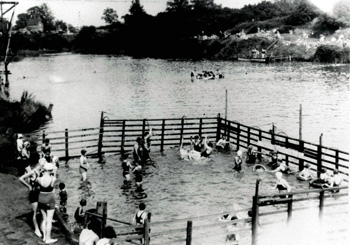Spinney Pool Leighton Buzzard

Bathers at Spinney Pool about 1930 [Z50/72/185]
Bedfordshire & Luton Archives & Records Service has notes on Spinney Pool compiled following an interview with Raymond Vivian Willis in December 1991 [CRT130/Lei57]. The pool lay on the west side of Billington Road and immediately south of today's Chartmoor Road right against the parish boundary with Billington. The notes are as follows.
"A large sand pit (300 to 400 by 50 yards) on the Billington Road was filled with spring water to a depth of about 30 feet in 1921. Raymond Willis (father of Raymond Vivian Willis), a builder and carpenter/joiner, and another swam in it and formed the Leighton Buzzard Swimming Club with six or seven other men".
"Staging (including six diving boards up to a height of 36 feet), huts (separate male and female) and a crib (timber framed) structure used as a more shallow learning area of 3 to 4 feet in depth were all added to the pool. From 1922 National Championships of the Amateur Swimming Association were held there as part of the August gala which included an evening carnival. The national swimming and diving competitions were attended by large numbers of spectators, who sat on the banks around the pool, and included speed boats, hydroplanes and water skiing".
"In 1931 the owners of the pool, who had let the pool land year by year to the Club, wanted to sell the land. They offered it for £600 and issued shares. Businesses in the town chipped in and bought the pool from the sand merchants Joseph Arnold. The Spinney Pool Company was formed".
"After 1939 the Bank Holiday spectacle was no longer held. Swimming was still possible in the pool and fishing. As a result of the construction of the Battlesden water pumping station in 1937/8 the level of the pool started to drop as water was drawn from the Greensand Ridge by the pumping station. By 1942/3 there was not enough water to swim. Dereliction set in in the following years".
"About 1960 Pentus Brown, a transport and haulage contractor, bought the pit and levelled the bottom to create a flat table. He built four warehouses on the site and let them. By 1967 two or three had started to have structural problems and shortly after Pentus Brown sold out to Anglo-Properties of London who had a dispute with Leighton-Linslade Urban District Council over a planning application affecting the land".